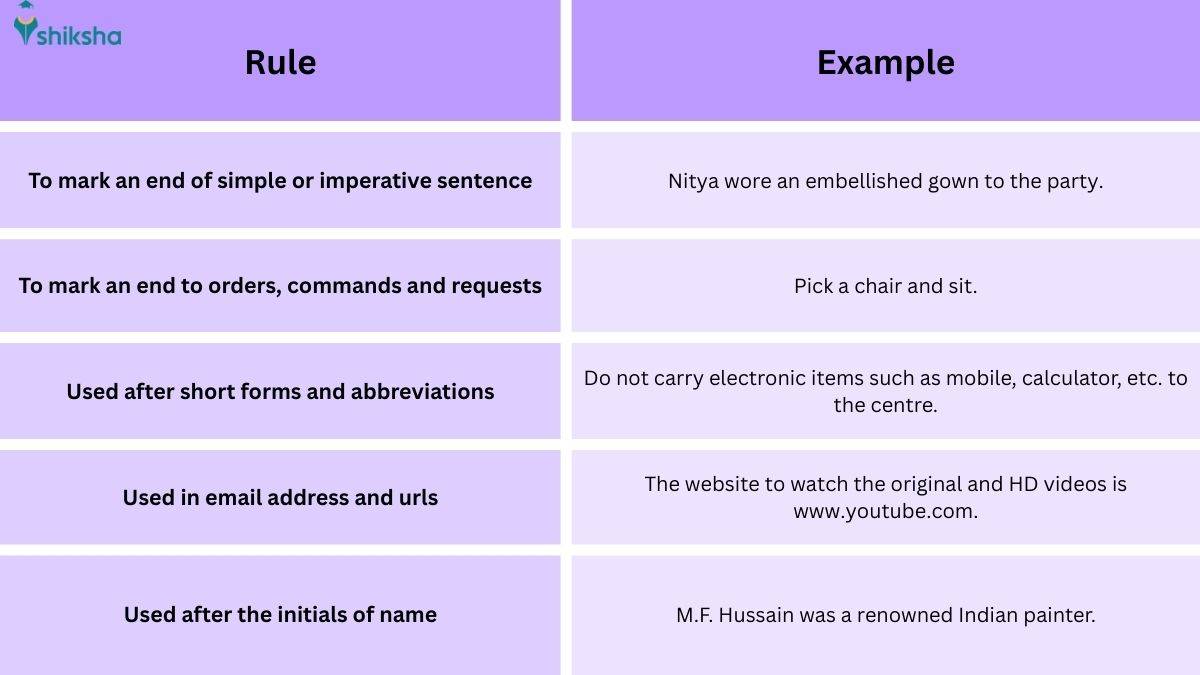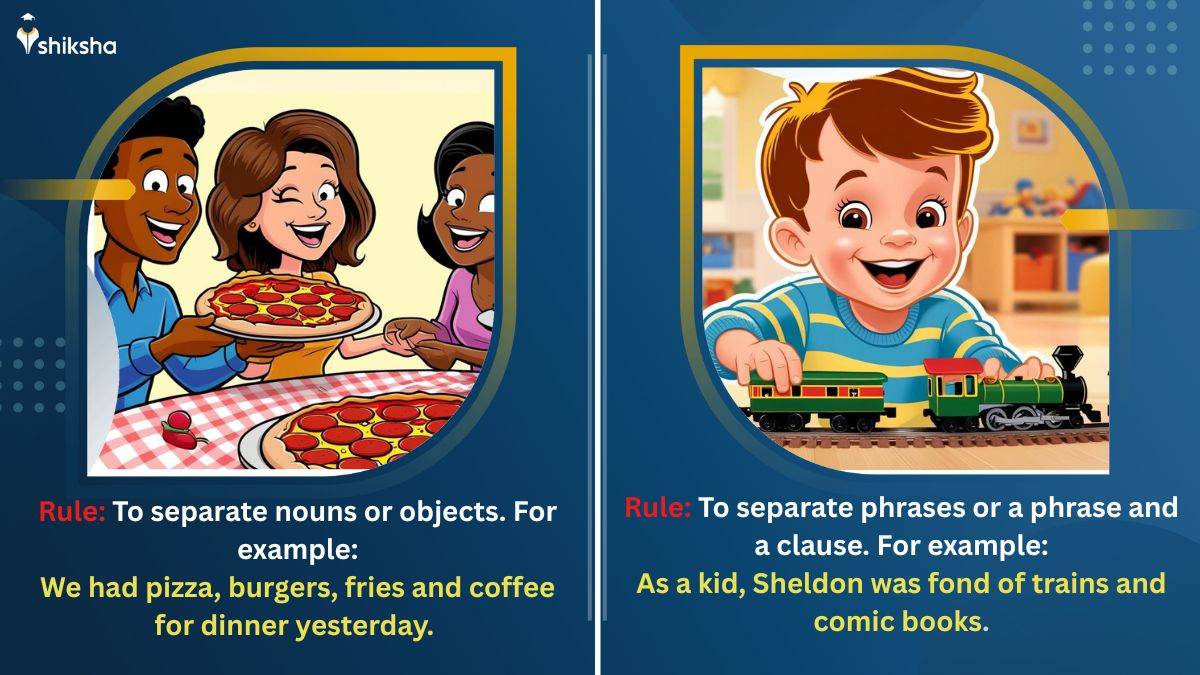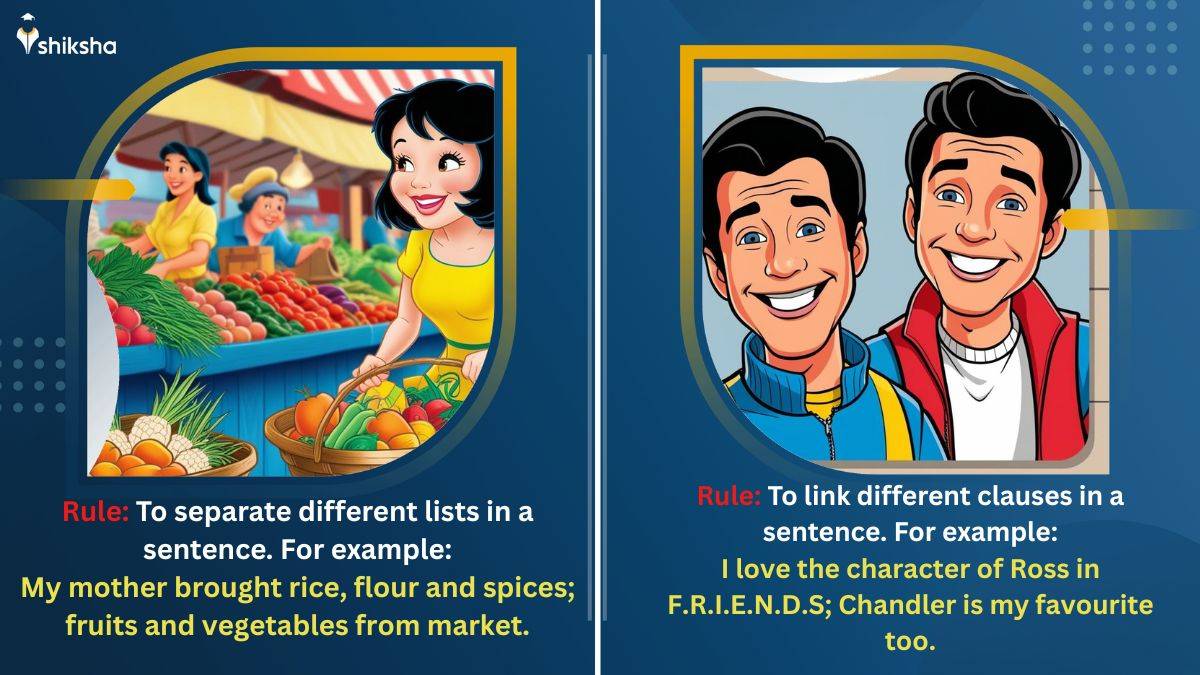
Punctuation refers to the use of marks or symbols to separate sentences or phrases to make them more meaningful and clear. Punctuation marks are one of the important parts of the English language, which show the following cases: the pause in a sentence, where the sentence ends and whether the sentence is questioning the reader or providing details or explanations or expressing some emotion. The basic English punctuation marks used in sentences are period (full stop), comma, apostrophe, quotation mark, exclamation mark, colon, semicolon, question mark, parenthesis, brackets, braces, dash, hyphen and ellipsis.
We have explained here the punctuation marks with symbols and their uses. Also, check below the punctuation rules with examples and practice exercises or worksheets with answers.
Also Read: Vocabulary Words with Meaning
What is punctuation?
Punctuation is a set of marks used in a sentence to add clarity and meaning in the piece of writing. There are 14 punctuation marks in English. These punctuations are:
- Commas
- Period or Full Stop
- Apostrophes
- Colon
- Semicolon
- Exclamation mark
- Question mark
- Parenthesis
- Brackets
- Braces
- Dash
- Hyphen
- Ellipsis
- Quotation mark
What are the 5 punctuation marks?
There are 14 punctuation marks in English. Of these, the commonly used 5 punctuation marks are:
- Commas
- Period or Full Stop
- Apostrophes
- Exclamation mark
- Question mark
- What is Punctuation in English?
- Definition of English Punctuation
- Types of Punctuation with Symbols & Uses
- Rules of Punctuation with Examples
- Difference Between Hyphen & Dash Punctuations
- Preparation Tips to Master English Punctuation
- Best Books for Punctuation in English Grammar
- Punctuation Examples
- English Punctuation Exercises with Answers
- Related English Topics for Preparation
- Frequently Asked Question (FAQs) on Punctuation
What is Punctuation in English?
Punctuations in English are the marks or symbols used in sentences to describe a pause, connection and the end. The use of punctuations in sentences makes them easier to understand, similar to the pauses one takes while communicating. For example, the sentence ‘How beautiful the city is!’ expresses admiration through the use of a punctuation exclamation mark (!) at the end. However, in case the same sentence ended with the question mark (?), it becomes an interrogative one asking the reader to tell about the beauty of the city.
Also Read: Prepositions Types & Examples
Commonly asked questions
What are the three main types of ending punctuation?
Some punctuations are categorized as end punctuations. The end punctuations are:
- Periods (.) – It is used to mark an end to the sentences.
- Question marks (? ) – It is used to end the sentence to indicate a query or direct question.
- Exclamation marks (!) – It is used to end the sentence to indicate emphasis or strong emotions.
What is an ellipsis used for?
Ellipsis is an English punctuation mark with the symbol “.”. An ellipsis is three evenly spaced dots, which indicates an incomplete thought or omission of some words. These three dots show that the sentence has been left incomplete deliberately.
For example: I am not sure what to do … I think we should take a break.
Definition of English Punctuation
Have a look at the punctuation definition below:
Definition of Punctuation as per Oxford Dictionary
“The marks used in writing that divide sentences and phrases; the system of using these marks.”
Definition of Punctuation as per the Cambridge Dictionary
“(the use of) special symbols that you add to writing to separate phrases and sentences to show that something is a question, etc.”
Pronunciation: /puhngk·choo·ay·shn/
Origin: The punctuation is a noun word that originated from medieval Latin punctuatio(n- ), which came from the verb punctuare.
Also Read: Verbs Rules with Examples
Types of Punctuation with Symbols & Uses
The most commonly used punctuation marks in English Grammar are 14, which make written English easier to read and understandable. Have a look at the 14 types of Punctuation with Symbols and their uses below:
| Types |
Symbol |
Use |
|---|---|---|
| Period or Full Stop |
. |
To indicate the end of the imperative or simple sentence |
| Comma |
, |
To separate parts of sentences or pauses, or links dependent clauses |
| Question Mark |
? |
To mark the end of a question or an interrogative sentence |
| Exclamation Mark |
! |
Expresses strong emotions such as happiness, sad, anger, admiration, shock, surprise, etc. |
| Quotation Marks |
“ ” |
Used to quote the words of a speaker or a statement owned by someone, or a quotation |
| Colon |
: |
To introduce a list, explanation, example or to link two related sentences |
| Semi-Colon |
; |
To separate different items in a sentence that already contains a comma, or to separate two independent clauses |
| Apostrophe |
‘ |
To show ownership or possession of something or form contractions by missing letters or numbers |
| Hyphen |
- |
Combines two words to form compound words, or describes time zones or dates |
| Dash |
– |
To describe a break, a long pause, or to explain extra information |
| Parentheses |
() |
To provide extra information |
| Brackets |
{}, [] |
To change the original word or add a comment, or to clarify. These are used more in mathematical equations and coding languages |
| Slash |
/ |
To show options or choices, to express ‘per’, used in dates and fractions |
| Ellipsis |
… |
To deliberately leave the sentence incomplete when the meaning is clear |
Also Read: Tense Types with Examples
Rules of Punctuation with Examples
Each punctuation mark has its own rules for usage in English Grammar. Knowing the punctuation rules is crucial not only for writing perfectly but also given appearing for competitive exams such as the SSC GD exam, TET exams, RRB exams, etc., as candidates are asked about the right usage of punctuation. Look at the rules of English Punctuation with examples below:
Rules for Full Stop/ Period
Have a look at the punctuation rules for the full stop with examples below:
Rules for Commas
Have a look at the rules for comma punctuation with examples below:
Rules for Question Mark
The question mark is used in the following situations:
| Rule |
Example |
|---|---|
| To end a direct question or interrogative sentence. |
|
| To end the sentences with question tags. |
|
However, the use of question mark punctuation is avoided if the question is described in indirect speech. Have a look at such an example below in both forms – direct and indirect speech:
- Question mark in Direct Speech: My dad asked, ‘Where are you going? ’
- No question mark in Indirect Speech: My dad asked where I was going.
Rules for the Exclamation Mark
The use of an exclamation mark expresses strong emotions such as:
- Excitement: Hurray! I am going on a holiday.
- Surprise: Wow! That’s the best birthday gift ever.
- Joy: Yay! We are moving to our city of dreams.
- Anger: How insensitive can he be!
- Pain: Ouch, that hurts!
- Admiration: What a wonderful evening!
Rules for Quotation Marks
The quotation mark rules are as follows:
| Type |
Example |
|---|---|
| Single quotation marks are used for naming books, names, movies and specific characters. |
‘High School English Grammar and Composition’ is one of the best books for English grammar. |
| Double quotation marks are used to quote someone in exact words. |
The teacher asked, “Who is the class monitor”? |
Note: Never leave the quotation marks open. Always close the marks as they are used in pairs.
Rules for Colon
The Colon is used in the following cases:
- To show a list of items or objects-
- Used in citations and references-
- To state a point, time and ratio such as 6:30 am, 1:3, etc.
Have a look at the dos and don’ts regarding the usage of Colon punctuation:
| Dos |
Don’ts |
|---|---|
| Use a space after the colon |
Do not use a colon after words such as namely, like, includes, such as, especially, generally, etc. |
| For example: The ingredients for baking a cake are: flour, baking soda, vanilla essence, butter, salt and sugar. |
For example: There are so many beautiful cities in the world namely Paris, Rome, Singapore, London, etc. |
Rules for Semicolon
The image below describes the rules for using Semicolon punctuation along with the example:
Rules for Apostrophe with Examples
Have a look at the Apostrophe rules with examples below:
| Rule |
Example |
|---|---|
| Shows ownership or possession |
Reema’s cat went missing today. I am my father’s daughter. |
| To form contractions |
Don’t judge the book by its cover. As per the weather forecast, it won’t rain today. |
Rules for Parentheses & Brackets
The parentheses are round brackets () and Brackets, in English Grammar, are square [], curly {} and angled < > ones. Have a look at the rules of these brackets with examples below:
| Type & Rule |
Example |
|---|---|
| Parentheses () are used to provide additional details. |
The Reserve Bank of India (RBI) releases the monetary policy quarterly every year. Jaipur (also known as Pink City) is the capital of Rajasthan. |
| Square Brackets [] are used to make changes in the original words for further clarification or to add a comment. |
Jehan did everything by himself; he never asked me [or anyone else] for help. |
| Curly Brackets {} are used to describe options within a category in a sentence. |
Fruits {apple, banana, guava, watermelon, etc.} and vegetables {tomato, potato, cucumber, bell peppers, etc.} are fibre-rich foods. |
Also Read: List of English Synonyms
Difference Between Hyphen & Dash Punctuations
Hyphen (-) and Dash (–) appear almost the same to the readers. Dash punctuation looks like the hyphen, but is a little longer. The table below will help you understand the difference between a dash and a hyphen:
| Particular |
Hyphen |
Dash |
|---|---|---|
| Use |
To combine words to form compound words |
To show a break or long pause. |
| Rule |
Refers to physical quantities Shows time frames, distances, age and fractions |
It can be used in place of commas, colons or semicolons. |
| Example |
My great-grandfather built this house from scratch. One needs to study 3-4 hours daily to clear the exam. |
The Gandhi–Irwin Pact was signed in 1931 by Mahatma Gandhi. Tia – the girl from Sikkim – won the competition. |
Also Read: What are English Articles?
Preparation Tips to Master English Punctuation
Knowing punctuation and their correct usage is important when it comes to mastering the writing skills in the English Language. Moreover, the knowledge of English punctuation marks comes in handy when appearing for competitive exams such as UPSC exams, IBPO exams, SSC exams and others. Candidates can easily get hold of the punctuation in English grammar using the following preparation tips:
- Know every punctuation mark along with its uses and rules to clear the basics.
- Refer to the best punctuation books to know the roots, types, uses and other important details.
- Make written notes about each type of punctuation so that you remember it in the long run.
- Apply the use of punctuations while writing anything such as a complaint email to any service provider or the like.
- Read reliable materials such as newspapers and textbooks to know how different punctuations are used to describe any information, any emotion, any happening, etc.
- Undertake the practice by opting for English punctuation exercises available for free on various online platforms.
- Analyse your performance in the punctuation worksheet and work on your weak areas by practising more.
Also Read: Precis Writing Meaning & Rules
Best Books for Punctuation in English Grammar
Students can refer to the following best English Punctuation books to study, understand and gain command over them:
| Name of the Book |
Author/ Publisher |
|---|---|
| The Best Punctuation Book, Period |
June Casagrande |
| The Blue Book of Grammar and Punctuation |
Jane Straus and Lester Kaufman |
| English Grammar & Punctuation |
Shelley Evans-Marshall |
| Oxford Primary Grammar, Punctuation And Spelling Dictionary |
Paperback |
Punctuation Examples
English Punctuation Exercises with Answers
Related English Topics for Preparation
Frequently Asked Question (FAQs) on Punctuation
Commonly asked questions
What are the 4 most common punctuation marks with examples?
Have a look at the 4 common punctuation marks in English with examples below:
- Full Stop/ Period (.)- The CAT jumped over the table.
- Comma (, )- She brought snacks, fruits and deserts for the party.
- Question Mark (? )- Did you visit the dentist?
- Exclamation Mark (!)- Wow! you look wonderful today.
What are the 14 punctuation marks with symbols?
There are 14 punctuation marks in English Grammar. Have a look at these 14 punctuation marks with symbols below:
Types | Symbol |
|---|---|
Period or Full Stop | . |
Comma | , |
Question Mark | ? |
Exclamation Mark | ! |
Quotation Marks | “ ” |
Colon | : |
Semi-Colon | ; |
Apostrophe | ‘ |
Hyphen | - |
Dash | – |
Parentheses | () |
Brackets | {}, [] |
Slash | / |
Ellipsis | … |
English Punctuation Exam
Student Forum
Other Topics under this Chapter
Other Class 10th English Chapters
- English Past Tense
- English Idioms
- English Punctuation
- English Analogy
- English Interjections
- English Prefixes
- English Adjectives
- English Future Continuous Tense
- English Letter Writing
- English Suffix
- English Grammar
- English One Word Substitution
- English Mood
- English Direct and Indirect Speech
- English Figures of Speech
- English Composition
- English Para Jumbles
- English Reading Comprehension
- English Sentences
- English Auxiliary and Modal Verbs
- English Formation of Words
- English Precis Writing
- English Nouns
- English Adverbs
- Conjunctions
- English Prepositions
- English Verbs
- English Paraphrasing
- English Articles
- English Subject and Predicate
- English Pronouns
- English Tenses
- English Active and Passive Voice
- English Vocabulary
- English Subject Verb Agreement
- English Phrases
- English Synonyms
- English Etymology and Roots
- English Spelling Rules
- English Parts of Speech
- English Gerunds



